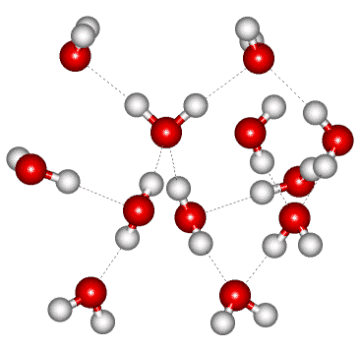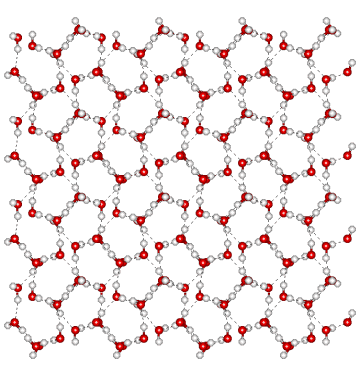
Ice III unit cell

Ice-three (ice III) is formed from water at 300 MPa by lowering its temperature to 250 K (see Phase Diagram). It is stable over a relatively small range of conditions in the P-T phase space. Its unit cell, which forms tetragonal crystals (Space group P41212, 92; Laue class symmetry 4/mmm; analogous to keatite silica), is shown on the right. All water molecules are hydrogen-bonded to four others in the crystal, two as donors and two as acceptors. Ice III contains five-membered rings joined as bicyclo-heptamers and has a density of 1.16 g cm-3 (at 350 MPa where water density = 1.13 g cm-3). The hydrogen bonding is disordered and continuously changing, as in hexagonal ice. The tetragonal crystal (shown below) is pseudo-cubic with cell dimensions 6.666 Å (a) and 6.936 Å (c; 90º, 90º, 90º; at 250 K and 280 MPa) [385] and contains 12 water molecules. Its structure consists of tight right-handed a four-fold helices, containing two-thirds of the water molecules, connected by the remaining water molecules, which, thus experience a differing molecular environment.
Ice-three crystal

Metastable ice-three may be formed within the ice-two phase space by raising the compression rate in the density-driven phase transition from hexagonal ice down to 170 K [1545].
Ice-three has triple points with liquid water and ice Ih (-21.985 °C, 209.9 MPa), liquid water and ice-five (-16.986 °C, 350.1MPa), ice Ih and ice-two (-34.7 °C, 212.9 MPa) and ice-two and ice-five (-24.3 °C, 344.3 MPa). The relative permittivity (dielectric constant) of ice-three is about 117. The Gibbs energy representation for ice III has been reported [3697].
Note that in this structural diagram (left), the hydrogen bonding is ordered, whereas in reality it is random (obeying the 'ice rules': two hydrogen atoms near each oxygen, one hydrogen atom on each O····O bond). This disorder gives rise to a zero-point entropy close to 3.423 J mol−1 K−1 [2153]. As the H-O-H angle does not vary much from that of the isolated molecule, the hydrogen bonds are not straight (although shown so in the figures).
The melting curve for ice-three is given by  MPa [1320]. The SeaFreeze package allows the computation of the thermodynamic (phase boundaries, density, entropy, specific heat, isothermal bulk modulus, adiabatic bulk modulus, thermal expansivity, chemical potentials) and elastic properties of ice III over the 0-2300 MPa and 220-500K range [3832].
MPa [1320]. The SeaFreeze package allows the computation of the thermodynamic (phase boundaries, density, entropy, specific heat, isothermal bulk modulus, adiabatic bulk modulus, thermal expansivity, chemical potentials) and elastic properties of ice III over the 0-2300 MPa and 220-500K range [3832].
The ordered hydrogen-bonding form of ice III is ice IX (ice-nine).
Interactive Jmol structures are given.
a Therefore the crystals are chiral. [Back]
Home | Site Index | Phase Diagram | Ices, introduction | Ice-Ih | Ice-Ic | Ice-Isd | II | IV | V | VI | VII | VIII | IX | X | XI | XII | XIII | XIV | XV | XVI| XVII | XVIII | Amorphous ice | LSBU | Top
This page was established in 2002 and last updated by Martin Chaplin on 12 September, 2021